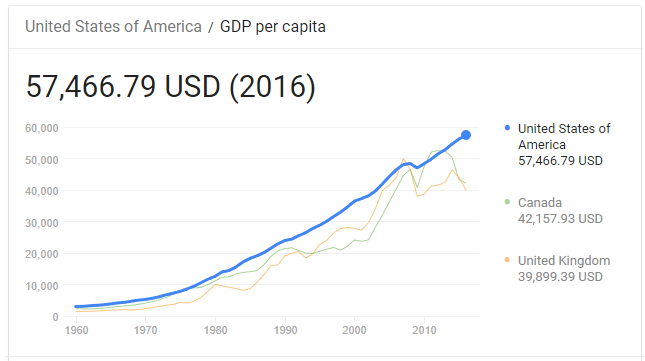I’ve seen this exact flawed argument pop up sometimes in discussions here in Europe. Just because something was a good idea a few centuries ago doesn’t mean it’s automatically a good idea now.
It isn’t really an argument that anything was a good idea a few centuries ago, but maybe another example of authoritarian nativism which we chose to walk away from.
But the reason is the same: Economics and growth. Much of US GDP growth is down to population growth, as is the ability to fund the social safety net, and immigration is a substantial factor in population growth. That’s as true now as it was then.
Eh, not really. I mean, we measure our GDP per capita, so it’s not only going up because the population is growing.

Another bad faith response. We don’t only measure GDP per capita. And are you denying that population growth is a factor in GDP growth? Really?
It was not bad faith at all. Please don’t go down that road.
Of course it does.
But when you look at per capita GDP growth, you see that the suggestion that it mainly grows due to population is objectively false.
To me, the fact that there’s growth per capita means every extra person coming in is that much more valuable, even if there is limited growth without them. And he didn’t say “mainly” @Timex, but much.
Yeah, don’t accuse people of bad faith at the drop of a hat, please.
I’m not sure how that’s bad faith. It is a legitimate factor in GDP growth. Population growth helps, but the two are important links.
Put another way, India and China. India has stronger population growth, China stronger GDP per capita growth. Both are about the same size in population.
Which one has their economy growing more? GDP per capris is absolutely relevant when you are talking about funding social programs.
Which Timex seems to be denying, which is Scott’s point, I think.
If you’re going to measure something per capita, a better measure is real median family income. The problem with GDP per capita is that you can have a growing GDP per capita but stagnant incomes for actual people, because the additional GDP is just sitting in corporate coffers. Which is more or less what we’ve seen over the last 18 years:
If you want to see why people on both the left and right are pissed about the economy, just click on that link and look at the graph. It used to be the case that families could count on a rising real income over time; that was still true during the economically troubled 70s and 80s.
But it wasn’t true from 2000 to 2015; family incomes stagnated or fell. (And hey, guess what, Trump showed up just in time to grab credit after things started turning around in 2015.)
But per capita GDP growth is not limited. I mean, look a that graph. The US enjoys pretty consistent GDP growth, per capita. In the past 10 years, it’s gone up, what, like 20%?
With respect, this is moving the goalposts. If you want to say that per capita GDP growth isn’t the best economic indicator, that’s totally fine. But the fact remains that GDP growth in the US has consistently gone up, independently from the population.
I haven’t seen anyone deny that. You guys are talking past each other over the word “much”. It’s a combo of the two. Let’s move on.
Just so everyone is clear too, I’m not at all against immigration. I think the US should dramatically relax its immigration stance. I think anyone who wants to come here should be allowed to.
This is so central to our current problems. Economic growth doesn’t mean much if no one but maybe the top 10% benefit from ANY of it. And even among that group, the distribution is horribly unequal.
Bad faith is bad faith. I didn’t say ‘most’ or ‘mainly’. And the response from @Timex ignored the broader point of my response - that the reasons to favor immigration now are quite similar to those of 200 years ago - and instead offered a pointless quibble about ‘much’. That’s bad faith.
Over that same period, immigration has accounted for 50%(!) of labor force growth.
“Between 2000 and 2015 the growth of the immigrant population constituted 50 percent of U.S. population and labor force growth (see this EconoFact memo for details on how labor force growth factors into economic growth). Without immigration, population growth in the United States would have been only 0.5 percent per year since 1965, while with immigration it has been close to 1.0 percent per year, according to a report by the Pew Research Center.”
I was going to point something out, but it may be more useful to just better understand what your original point was.
When i read your original post, i interpreted it as suggesting that GDP growth in the US was mainly due to population growth (as is the case in some other countries which had weak overall growth but negative per capita growth). Clearly i misunderstood what your actual position was. Was it simply that population growth increases GDP?
That population growth is a substantial part of GDP growth, and that immigration is a substantial part of population growth. More to the point, that these were more or less the reasons the colonials wanted more immigration into the colonies, and those reasons remain valid now, so one can’t dismiss the argument as outdated.
Meanwhile… Thank you for your service. Now get the hell out of the country: